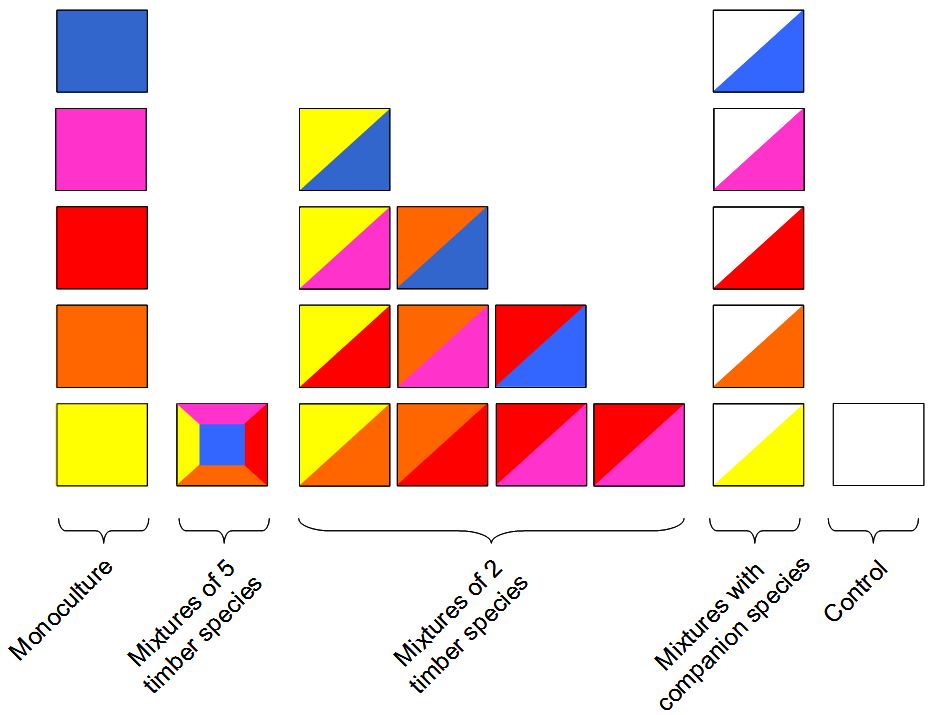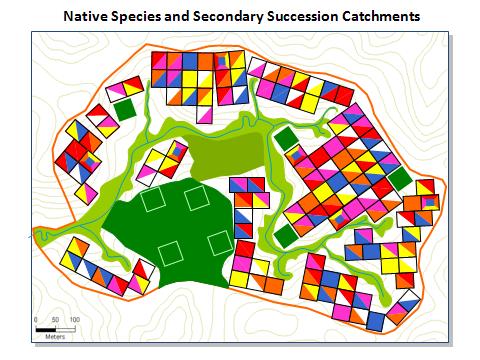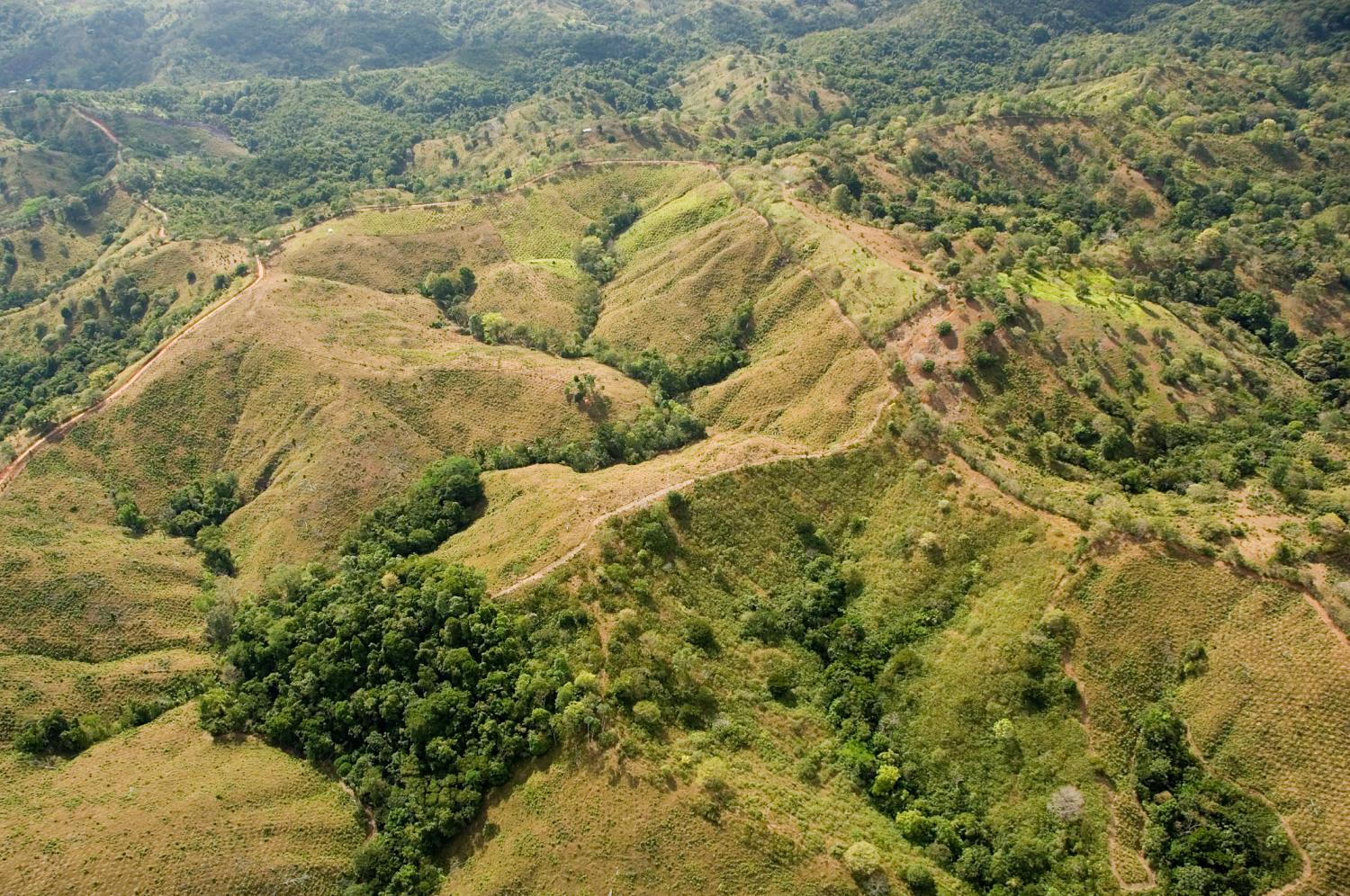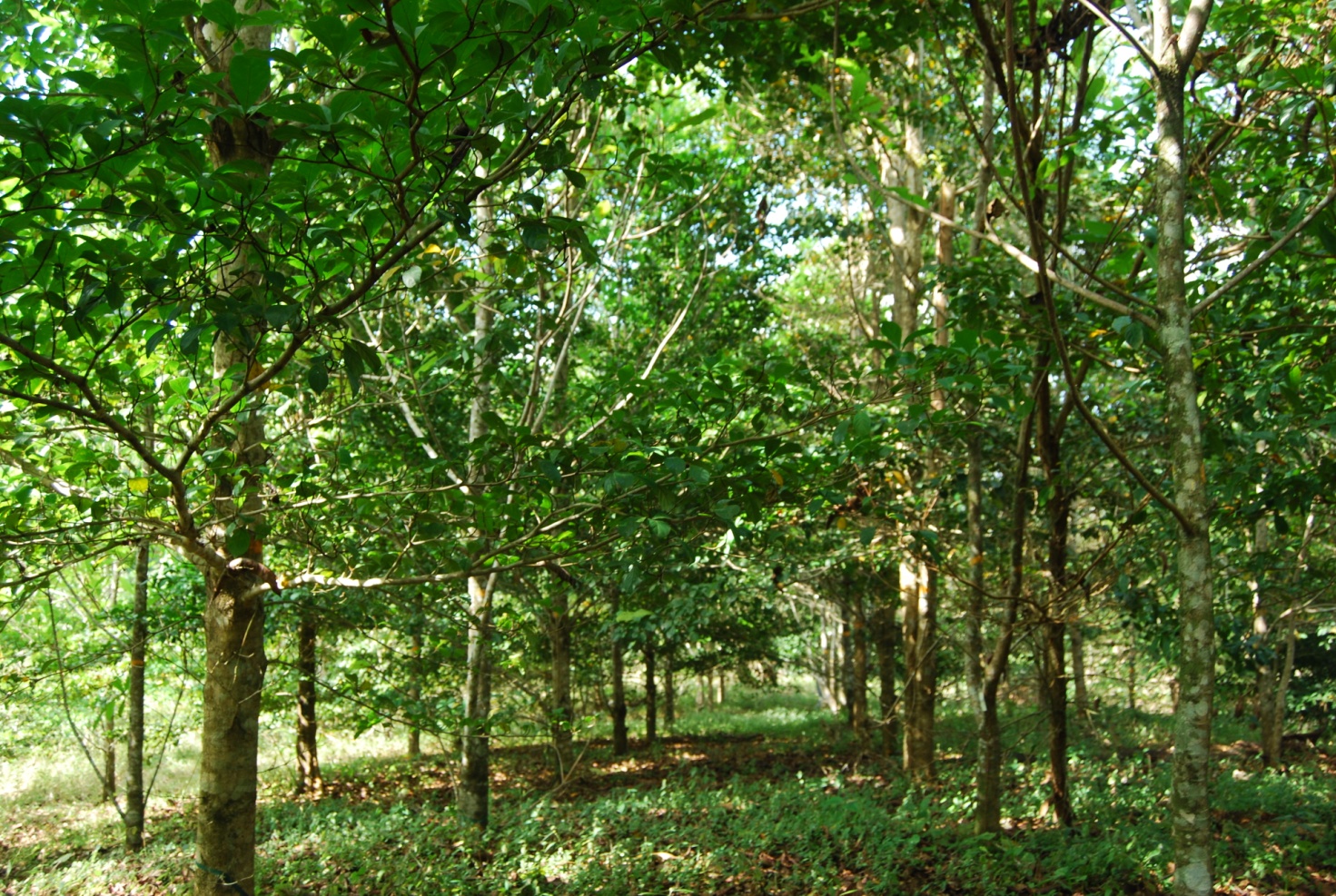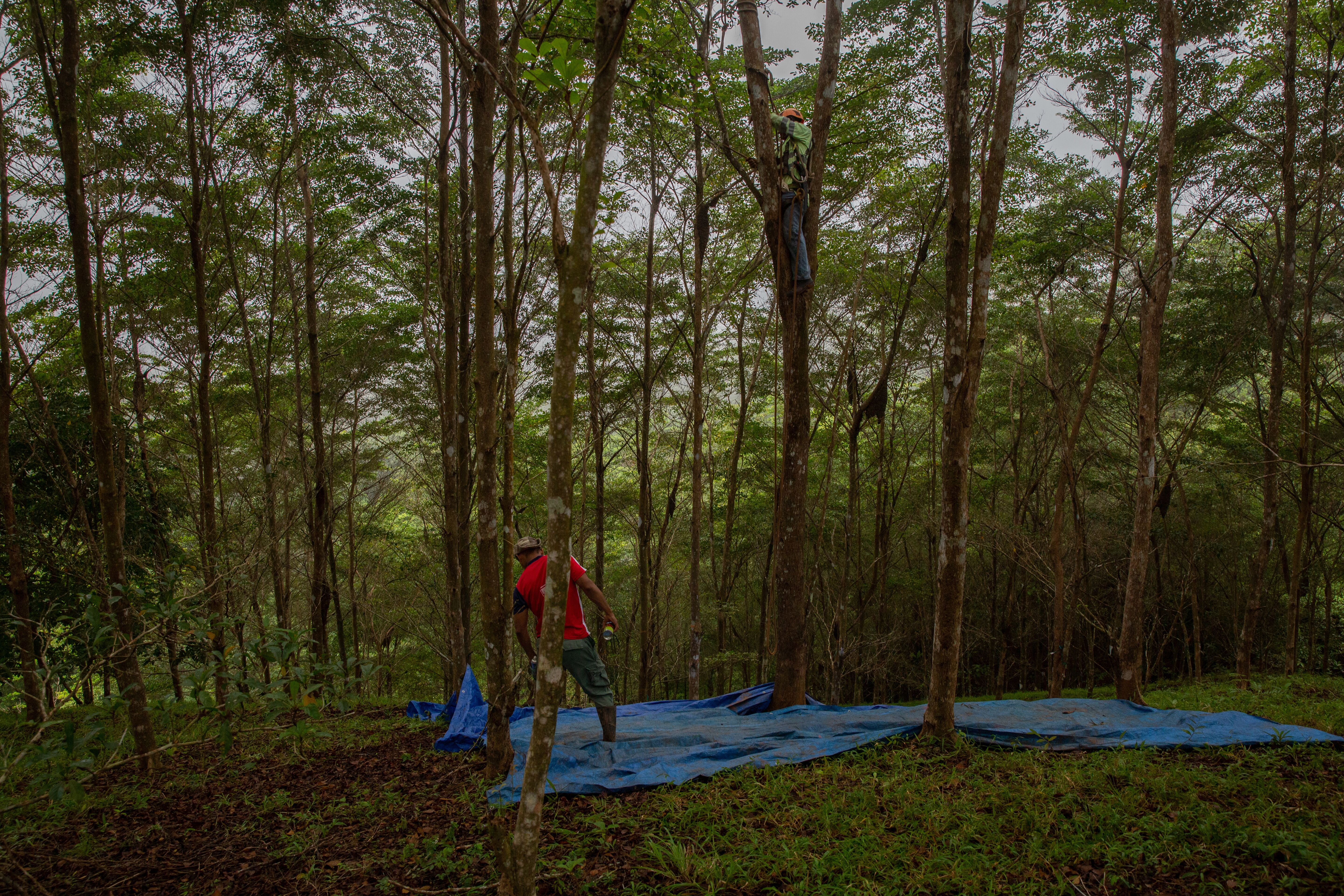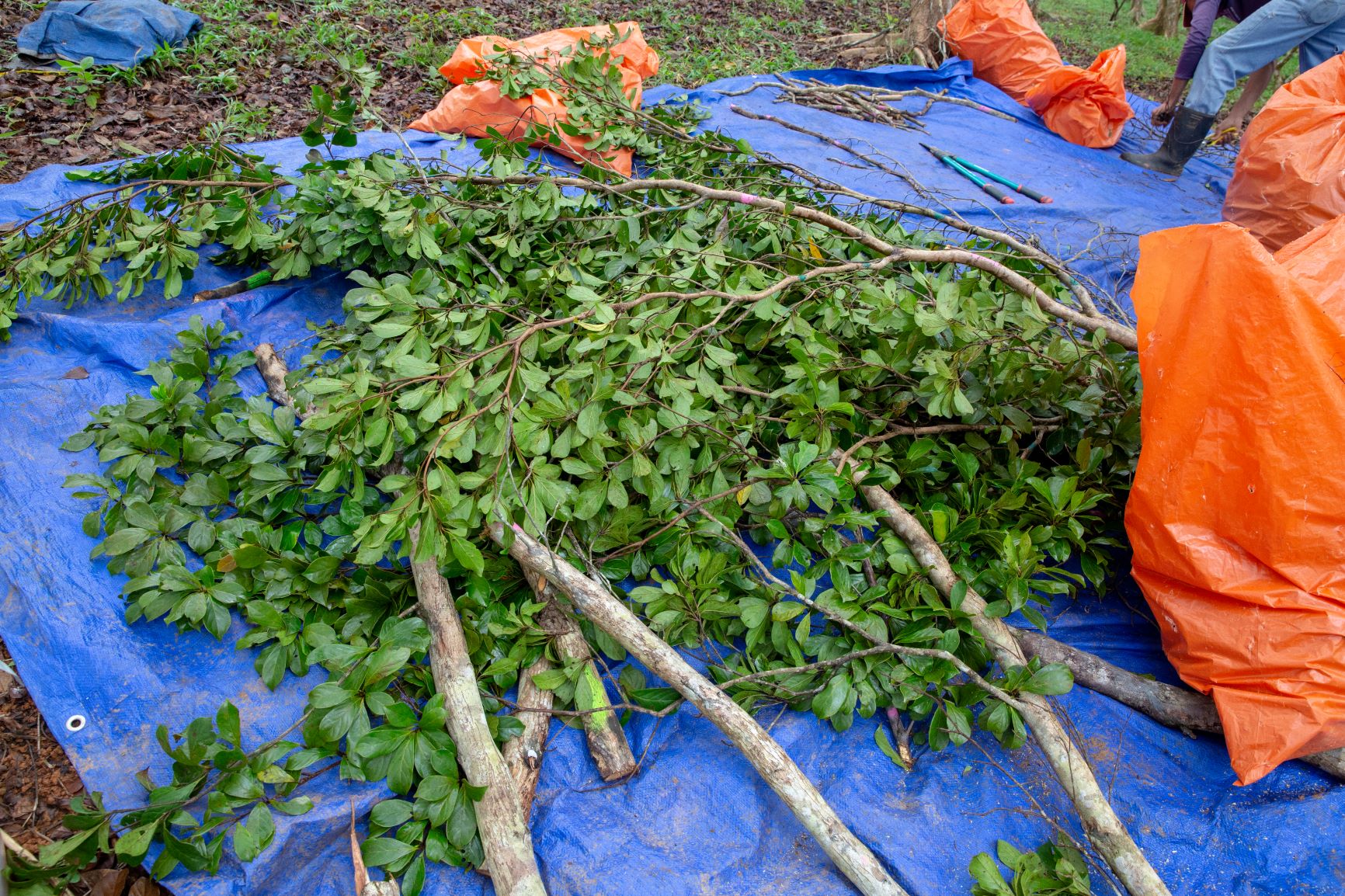Agua Salud (Panama)
The Native Species Plantation within the overall Agua Salud Project was established in 2008. The plantation is designed to test hypotheses related to the growth and development of native species in monocultures and mixtures as well as ecosystem function and services. Native timber species were chosen as target species as the overall theme of the project is related to understanding ecosystem services and as carbon credits alone will not cover the establishment and management costs of plantations in Panama.
There is an application trial linked to this experiment.
Design
The Agua Salud Native Species Plantation is approximately 75 hectares and is divided into two blocks of roughly equivalent size that are 3 kilometres apart. Each block contains 21 different treatments (mixtures), each treatment present in 6 or more replicate plots. The plots are randomly distributed within a block.
The species were selected based on physiological and morphological traits, and the target species are long-lived pioneer species.
Site characteristics
| location | Agua Salud |
|---|---|
| former land use | cattle pasture |
| altitude | 200-300 m |
| soil type | Oxisols |
| area | 41 ha (plots), 75 ha (total area) |
| no of plots | 267 |
| plot size | |
| no of trees planted | 60 075 |
| planting date | July-September 2008 |
| diversity variables | species richness |
| diversity gradient | 1, 2, 5, 6 sp. |
| size species pool | 5 + 5 |
| species pool | timber species: Anacardium excelsum, Dalbergia retusa, Pachira quinata, Tabebuia rosea, Terminalia amazonia companion species: Erytrina fusca, Gliricidia sepium, Inga punctat, Luehea seemannii, Ochroma pyramidale |
| contact person | Jefferson Hall |
A meteorological station sends meteo data in real time to the web.
Extra information
For more information on the Agua Salud experiment, send an e-mail to the contact persons, visit the website of the Agua Salud project, or explore the publications:
- Sinacore K, García EH, Howard T, van Breugel M, Lopez OR, Finkral AJ, Hall JS (2022) Towards effective reforestation: growth and commercial value of four commonly planted tropical timber species on infertile soils in Panama. New Forests - https://doi.org/10.1007/s11056-022-09906-0
- Messier C, Bauhus J, Sousa-Silva R, Auge H, Baeten L, Barsoum N, Bruelheide H, Caldwell B, Cavender-Bares J, Dhiedt E, Eisenhauer N, Ganade G, Gravel D, Guillemot J, Hall JS, Hector A, Hérault B, Jactel H, Koricheva J, Kreft H, Mereu S, Muys B, Nock CA, Paquette A, Parker JD, Perring MP, Ponette Q, Potvin C, Reich PB, Scherer-Lorenzen M, Schnabel F, Verheyen K, Weih M, Wollni M, Zemp DC (2021) For the sake of resilience and multifunctionality, let's diversify planted forests! Conservation Letters e12829 - https://doi.org/10.1111/conl.12829
- Quesada-Ávila G, Turner BL, Hall JS (2021) No Evidence that the Valuable Timber Species, Dalbergia Retusa, Enhances Nutrient Cycling and Uptake by Neighboring Timber Species. Journal of Sustainable Forestry - https://doi.org/10.1080/10549811.2021.1989700
- Sinacore K, Asbjornsen H, Hernandez-Santana V, Hall J S (2020) Differential and dynamic water regulation responses to El Niño for monospecific and mixed species planted forests. Ecohydrology e2238 - https://doi.org/10.1002/eco.2238
- Kerdraon D, Drewer J, Castro B, Wallwork A, Hall J S, Sayer E J (2019) Litter traits of native and non-native tropical trees influence soil carbon dynamics in timber plantations in panama. Forests 10(3): 209 - https://doi.org/10.3390/f10030209
- Sinacore K, Asbjornsen H, Hernandez-Santana V, Hall J S (2019) Drought differentially affects growth, transpiration, and water use efficiency of mixed and monospecific planted forests. Forests 10(2): 153 - https://doi.org/10.3390/f10020153
- Mayoral C, van Breugel M, Turner B L, Asner G P, Vaughn N R, Hall J S (2019) Effect of microsite quality and species composition on tree growth: A semi-empirical modeling approach. Forest ecology and management 432: 534-545 - https://doi.org/10.1016/j.foreco.2018.09.047
- Roels SM, Porter JD, Lindell CA (2018) Predation pressure by birds and arthropods on herbivorous insects affected by tropical forest restoration strategy. Restoration Ecology 26: 6 - doi: 10.1111/rec.12693
- Batterman SA, Hall JS, Turner BL, Hedin LO, LaHaela Walter JK, Sheldon P, Van Breugel M (2018) Phosphatase activity and nitrogen fixation reflect species differences, not nutrient trading or nutrient balance, across tropical rainforest trees. Ecology Letters 21: 1486-1495 - doi: 10.1111/ele.13129
- Mayoral C, Van Breugel M, Cerezo A, Hall JS (2017) Survival and growth of five Neotropical timber species in monocultures and mixtures. Forest Ecology and Management 403: 1-11 - doi: 10.1016/j.foreco.2017.08.002
- Miller E, Dandois JP, Detto M, Hall JS (2017) Drones as a Tool for Monoculture Plantation Assessment in the Steepland Tropics. Forests 8(5): 168 - https://doi.org/10.3390/f8050168
- Guerrero-Ramírez NR, Craven D, Messier C, Potvin C, Turner BL, Handa IT (2016) Root quality and decomposition environment, but not tree species richness, drive root decomposition in tropical forests. Plant and Soil 404: 125-139 – https://doi.org/10.1007/s11104-016-2828-y
- Paul GS, Montagnini F, Berlyn GP, Craven D, Van Breugel M, Hall JS (2012) Foliar herbivory and leaf traits of five native tree species in a young plantation of Central Panama. New Forests 43: 69-87 - doi: 10.1007/s11056-011-9267-7

